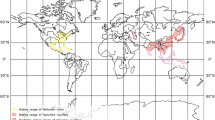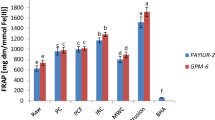Abstract
Parkia biglobosa seeds (African locust bean) play a crucial role in the diet and health of Western African populations. The seeds are spontaneously fermented to produce condiments used for food seasoning and stews preparation. Hence, to understand the health benefits of seed-based products from P. biglobosa, total polyphenol content, in vitro and ex vivo antioxidant properties, as well as antihypertensive activity, of fermented and non-fermented seeds were investigated. The Folin-Ciocalteu method was used to determine total polyphenol content; 2,2-diphenyl-1-picrylhydrazyl (DPPH) and ferric reducing antioxidant power (FRAP) tests were used to estimate the in vitro antioxidant activity. The ex vivo antioxidant and antihypertensive activities were evaluated by using cellular antioxidant activity in human red blood cells (CAA-RBC) and angiotensin-converting enzyme (ACE) inhibitory activity assays, respectively. The fermented seeds showed a huge increase in polyphenol content and in vitro antioxidant activities compared to non-fermented ones. The fermented seeds showed a higher potency of biological antioxidant activity than non-fermented ones by exhibiting greater protection of erythrocytes from oxidative damage at a very low dose of extracts. Both fermented and non-fermented seeds have been shown to contain peptides with ACE-inhibitory activity; however, the non-fermented seeds exerted a higher ACE-inhibitory activity than fermented ones. In conclusion, traditional fermentation positively impacted the nutraceutical and health benefits of P. biglobosa seeds. However, the non-fermented seeds should not be ignored. Both fermented and non-fermented seeds can be used as valuable ingredients for the formulation of functional foods.

Similar content being viewed by others
Data Availability
All data generated or analyzed during this study are available from the corresponding author upon reasonable request.
References
Food and Agriculture Organization of the United Nations, World Health Organization (2019) Sustainable healthy diets: guiding principles
Tamang JP, Cotter PD, Endo A et al (2020) Fermented foods in a global age: East meets West. Compr Rev Food Sci Food Saf 19:184–217. https://doi.org/10.1111/1541-4337.12520
Garrido-Galand S, Asensio-Grau A, Calvo-Lerma J et al (2021) The potential of fermentation on nutritional and technological improvement of cereal and legume flours: a review. Food Res Int 145:110398. https://doi.org/10.1016/j.foodres.2021.110398
Annunziata G, Arnone A, Ciampaglia R, Tenore GC, Novellino E (2020) Fermentation of Foods and Beverages as a Tool for increasing availability of Bioactive Compounds. Focus on short-chain fatty acids. Foods 9:999. https://doi.org/10.3390/foods9080999
Capozzi V, Fragasso M, Bimbo F (2021) Microbial Resources, Fermentation and reduction of negative Externalities in Food Systems: patterns toward sustainability and resilience. Fermentation 7:54. https://doi.org/10.3390/fermentation7020054
Zannou O, Agossou DJ, Miassi Y et al (2022) Traditional fermented foods and beverages: indigenous practices of food processing in Benin Republic. Int J Gastron Food Sci 27:100450. https://doi.org/10.1016/j.ijgfs.2021.100450
Adebo JA, Njobeh PB, Gbashi S et al (2022) Fermentation of Cereals and Legumes: Impact on Nutritional Constituents and Nutrient Bioavailability. Fermentation 8:63. https://doi.org/10.3390/fermentation8020063
Obafemi YD, Oranusi SU, Ajanaku KO et al (2022) African fermented foods: overview, emerging benefits, and novel approaches to microbiome profiling. Npj Sci Food 6:15. https://doi.org/10.1038/s41538-022-00130-w
Duodu KG, Apea-Bah FB (2017) Chap. 9 - African Legumes: Nutritional and Health-Promoting Attributes. In: Taylor JRN, Awika JM (eds) Gluten-Free Ancient Grains. Woodhead Publishing, pp 223–269
del López-Cortez S, Rosales-Martínez P, Arellano-Cárdenas S, Cornejo-Mazón M (2016) Antioxidants Properties and Effect of Processing Methods on Bioactive Compounds of Legumes. In: Goyal AK (ed) Grain Legumes. InTech
Owusu-Kwarteng J, Parkouda C, Adewumi GA et al (2022) Technologically relevant Bacillus species and microbial safety of west african traditional alkaline fermented seed condiments. Crit Rev Food Sci Nutr 62:871–888. https://doi.org/10.1080/10408398.2020.1830026
Okpara AN, Ugwuanyi JO (2017) Chap. 15 - Evolving Status of African Food Seasoning Agents Produced by Fermentation. In: Grumezescu AM, Holban AM (eds) Soft Chemistry and Food Fermentation. Academic Press, pp 465–505
Termote C, Odongo NO, Dreyer BS et al (2022) Nutrient composition of Parkia biglobosa pulp, raw and fermented seeds: a systematic review. Crit Rev Food Sci Nutr 62:119–144. https://doi.org/10.1080/10408398.2020.1813072
Yakubu CM, Sharma R, Sharma S (2022) Fermentation of locust bean (Parkia biglobosa): modulation in the anti-nutrient composition, bioactive profile, in vitro nutrient digestibility, functional and morphological characteristics. Int J Food Sci Technol 57:753–762. https://doi.org/10.1111/ijfs.15288
Marshall E, Mejía-Lorío DJ (2011) Traditional fermented food and beverages for improved livelihoods. FAO, Rome
Azokpota P, Hounhouigan DJ, Nago MC (2006) Microbiological and chemical changes during the fermentation of African locust bean (Parkia biglobosa) to produce afitin, iru and sonru, three traditional condiments produced in Benin. Int J Food Microbiol 107:304–309. https://doi.org/10.1016/j.ijfoodmicro.2005.10.026
Karou SD, Tchacondo T, Djikpo Tchibozo MA et al (2011) Ethnobotanical study of medicinal plants used in the management of diabetes mellitus and hypertension in the Central Region of Togo. Pharm Biol 49:1286–1297. https://doi.org/10.3109/13880209.2011.621959
Dièye AM, Sarr A, Diop SN et al (2008) Medicinal plants and the treatment of diabetes in Senegal: survey with patients. Fundam Clin Pharmacol 22:211–216. https://doi.org/10.1111/j.1472-8206.2007.00563.x
Abo KA, Fred-Jaiyesimi AA, Jaiyesimi AEA (2008) Ethnobotanical studies of medicinal plants used in the management of diabetes mellitus in South Western Nigeria. J Ethnopharmacol 115:67–71. https://doi.org/10.1016/j.jep.2007.09.005
Ognatan K, Adi K, Lamboni C et al (2011) Effect of Dietary Intake of Fermented Seeds of Parkia biglobosa (Jacq) Benth (African Locust Bean) on hypertension in Bogou and Goumou-kope Areas of Togo. Trop J Pharm Res 10:603–609. https://doi.org/10.4314/tjpr.v10i5.9
Ogunyinka BI, Oyinloye BE, Osunsanmi FO et al (2019) Protein isolate from Parkia biglobosa Seeds improves Dyslipidaemia and Cardiac oxidative stress in Streptozotocin-Induced Diabetic rats. Antioxidants 8:481. https://doi.org/10.3390/antiox8100481
Odetola A, Akinloye O, Egunjobi C et al (2006) Possible antidiabetic and antihyperlipidaemic effect of fermented Parkia Biglobosa (jacq) extract in Alloxan-Induced Diabetic Rats§. Clin Exp Pharmacol Physiol 33:808–812. https://doi.org/10.1111/j.1440-1681.2006.04444.x
Rendu F, Saleun S, Auger J (1993) Parkia biglobosa seeds possess anti platelet activity. Thromb Res 71:505–508. https://doi.org/10.1016/0049-3848(93)90124-7
Oboh G, Alabi KB, Akindahunsi AA (2008) Fermentation changes the nutritive value, Polyphenol distribution, and antioxidant Properties of Parkia biglobosa Seeds (African Locust Beans). Food Biotechnol 22:363–376. https://doi.org/10.1080/08905430802463404
Silva HC, Bari AU, Rocha BAM et al (2013) Purification and primary structure of a mannose/glucose-binding lectin from Parkia biglobosa Jacq. Seeds with antinociceptive and anti-inflammatory properties. J Mol Recognit 26:470–478. https://doi.org/10.1002/jmr.2289
Ayo-Lawal RA, Sibuyi NR, Ekpo O et al (2020) Investigation of the anti-cancer and apoptotic properties of aqueous extract from fermented African locust bean seeds. Food Res 5:203–210. https://doi.org/10.26656/fr.2017.5(1).295
Samtiya M, Aluko RE, Dhewa T, Moreno-Rojas JM (2021) Potential health benefits of Plant Food-Derived Bioactive Components: an overview. Foods 10:839. https://doi.org/10.3390/foods10040839
Chu AJ (2022) Quarter-Century Explorations of Bioactive Polyphenols: Diverse Health benefits. Front Biosci-Landmark 27:134. https://doi.org/10.31083/j.fbl2704134
Aluko RE (2019) Food protein-derived renin-inhibitory peptides: in vitro and in vivo properties. J Food Biochem 43:e12648. https://doi.org/10.1111/jfbc.12648
Aluko RE (2015) Structure and function of plant protein-derived antihypertensive peptides. Curr Opin Food Sci 4:44–50. https://doi.org/10.1016/j.cofs.2015.05.002
Leonard W, Zhang P, Ying D et al (2021) Fermentation transforms the phenolic profiles and bioactivities of plant-based foods. Biotechnol Adv 49:107763. https://doi.org/10.1016/j.biotechadv.2021.107763
Daramola B (2014) Comparative analysis of antioxidative potentials of extracts of defatted unfermented and fermented locust beans. Bangladesh J Sci Ind Res 49:275–280. https://doi.org/10.3329/bjsir.v49i4.22632
Torino MI, Limón RI, Martínez-Villaluenga C et al (2013) Antioxidant and antihypertensive properties of liquid and solid state fermented lentils. Food Chem 136:1030–1037. https://doi.org/10.1016/j.foodchem.2012.09.015
Juan M-Y, Chou C-C (2010) Enhancement of antioxidant activity, total phenolic and flavonoid content of black soybeans by solid state fermentation with Bacillus subtilis BCRC 14715. Food Microbiol 27:586–591. https://doi.org/10.1016/j.fm.2009.11.002
Dueñas M, Fernández D, Hernández T et al (2005) Bioactive phenolic compounds of cowpeas (Vigna sinensis L). Modifications by fermentation with natural microflora and with Lactobacillus plantarum ATCC 14917. J Sci Food Agric 85:297–304. https://doi.org/10.1002/jsfa.1924
Gabriele M, Sparvoli F, Bollini R, et al (2019) The Impact of Sourdough Fermentation on Non-Nutritive Compounds and Antioxidant Activities of Flours from Different Phaseolus Vulgaris L. Genotypes. J Food Sci 84:1929–1936. https://doi.org/10.1111/1750-3841.14672
Limón RI, Peñas E, Torino MI, et al (2015) Fermentation enhances the content of bioactive compounds in kidney bean extracts. Food Chem 172:343–352. https://doi.org/10.1016/j.foodchem.2014.09.084
Polanowska K, Grygier A, Kuligowski M, et al (2020) Effect of tempe fermentation by three different strains of Rhizopus oligosporus on nutritional characteristics of faba beans. LWT 122:109024. https://doi.org/10.1016/j.lwt.2020.109024
Blasa M, Angelino D, Gennari L, Ninfali P (2011) The cellular antioxidant activity in red blood cells (CAA-RBC): A new approach to bioavailability and synergy of phytochemicals and botanical extracts. Food Chem 125:685–691. https://doi.org/10.1016/j.foodchem.2010.09.065
Manzoor M, Singh J, Gani A (2022) Exploration of bioactive peptides from various origin as promising nutraceutical treasures: In vitro, in silico and in vivo studies. Food Chem 373:131395. https://doi.org/10.1016/j.foodchem.2021.131395
Maleki S, Razavi SH (2021) Pulses’ germination and fermentation: Two bioprocessing against hypertension by releasing ACE inhibitory peptides. Crit Rev Food Sci Nutr 61:2876–2893. https://doi.org/10.1080/10408398.2020.1789551
Sanjukta S, Rai AK (2016) Production of bioactive peptides during soybean fermentation and their potential health benefits. Trends Food Sci Technol 50:1–10. https://doi.org/10.1016/j.tifs.2016.01.010
Martinez-Villaluenga C, Torino MI, Martín V, et al (2012) Multifunctional Properties of Soy Milk Fermented by Enterococcus faecium Strains Isolated from Raw Soy Milk. J Agric Food Chem 60:10235–10244. https://doi.org/10.1021/jf302751m
Hang M, Zhao X-H (2012) Fermentation time and ethanol/water-based solvent system impacted in vitro ACE-inhibitory activity of the extract of Mao-tofu fermented by Mucor spp. CyTA – J Food 10:137–143. https://doi.org/10.1080/19476337.2011.601428
Diaz M, Kellingray L, Akinyemi N, et al (2019) Comparison of the microbial composition of African fermented foods using amplicon sequencing. Sci Rep 9:13863. https://doi.org/10.1038/s41598-019-50190-4
Daskaya-Dikmen C, Yucetepe A, Karbancioglu-Guler F, et al (2017) Angiotensin-I-Converting Enzyme (ACE)-Inhibitory Peptides from Plants. Nutrients 9:316. https://doi.org/10.3390/nu9040316
Ayo-Lawal RA, Osoniyi O, Famurewa AJ, Lawal OA (2014) Evaluation of antioxidant and hypolipidaemic effects of fermented Parkia biglobosa (Jacq) seeds in tyloxapol-induced hyperlipidaemic rats. Afr J Food Sci 8:225–232. https://doi.org/10.5897/AJFS2013.1124
Ouédraogoa S, Somé N, Ouattara S, et al (2012) Acute Toxicity and Vascular Properties of Seed of Parkia Biglobosa (Jacq) R. Br Gift (Mimosaceae) on Rat Aorta. Afr J Tradit Complement Altern Med 9:260–265. https://doi.org/10.4314/ajtcam.v9i2.12
Acknowledgements
The authors would like to thank Valter Lubrano and Fondazione G. Monasterio CNR-Regione Toscana (Pisa, Italy) for providing human blood samples and Alfassassi Arouna (University of Lomé, Togo) for providing P. biglobosa seeds from Togo.
Funding
Not applicable.
Author information
Authors and Affiliations
Contributions
Author Contributions: Conceptualization: Nafiou Arouna, Morena Gabriele, Laura Pucci; Formal analysis: Nafiou Arouna, Morena Gabriele; Validation: Nafiou Arouna, Morena Gabriele; Investigation, Nafiou Arouna, Elena Tomassi; Data curation, N.A; Writing-original draft preparation, Nafiou Arouna; Writing-review and editing: Morena Gabriele, Laura Pucci; Supervision: Morena Gabriele, Laura Pucci; Project administration: Laura Pucci.
Corresponding author
Ethics declarations
Conflict of Interest
The authors declare no conflicts of interest.
Ethical Approval and Consent to Participate
Not applicable.
Consent for Publication
All authors consent to publish this manuscript.
Competing Interests
The authors declare no competing interests.
Additional information
Publisher’s Note
Springer Nature remains neutral with regard to jurisdictional claims in published maps and institutional affiliations.
Electronic Supplementary Material
Below is the link to the electronic supplementary material.
Rights and permissions
Springer Nature or its licensor (e.g. a society or other partner) holds exclusive rights to this article under a publishing agreement with the author(s) or other rightsholder(s); author self-archiving of the accepted manuscript version of this article is solely governed by the terms of such publishing agreement and applicable law.
About this article
Cite this article
Arouna, N., Gabriele, M., Tomassi, E. et al. Traditional Fermentation Affects the Nutraceutical Properties of Parkia biglobosa Seeds. Plant Foods Hum Nutr 78, 452–457 (2023). https://doi.org/10.1007/s11130-023-01064-8
Accepted:
Published:
Issue Date:
DOI: https://doi.org/10.1007/s11130-023-01064-8




